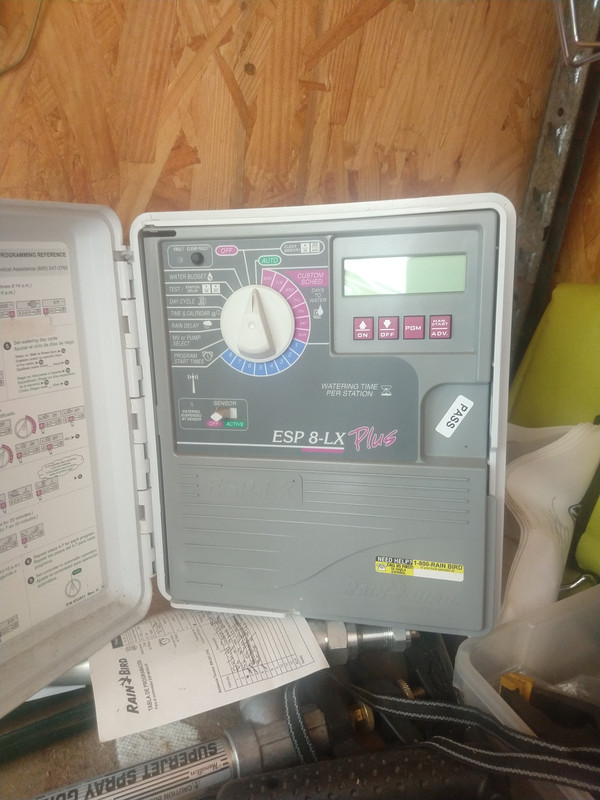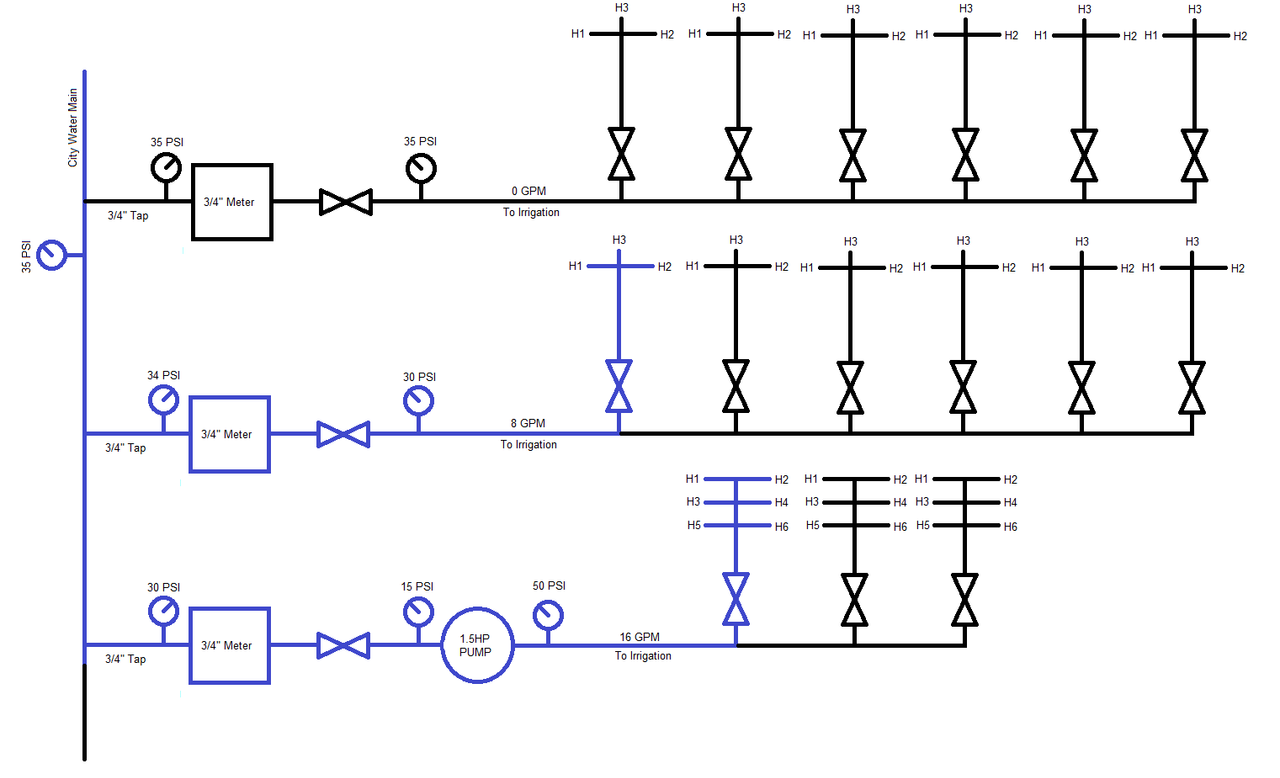You all may have seen it before, but I've inherited a piece of land with an existing irrigation system.
It's currently plumbed from his old irrigation meter (they still live next door). He had a 1" meter put in, and plumbed everything with 1" PVC. Main line, laterals, everything seems to be 1".
I had an irrigation meter put in on my property, and am in the process of getting everything plumbed to my meter.
A few of the irrigation zones are now on my meter, as well as our pool house and a few spigots around our pool.
Right now, while we're in transition phase, I have it plumbed so that, depending on how I have a few valves turned, I can have all of that running off either his meter OR mine.
I have 120' of 2" line before my side necks down to 1" to meet the existing pipe work that was there. My first spigot is in the 2" main line.
Even with me running 2" pipe, and his side all 1" pipe, when I test that spigot off my 3/4" meter I only get about 7 gpm.
When I shut off my meter, and open the valves to let the system be supplied by his 1" meter, I get 10 gpm from that spigot. Where that spigot lies coming from his meter there is probably 160', to maybe 200', of 1" pipe. Coming from my meter there is 120' of 2" pipe.
All this matters to me because there are two zones of sprinkler heads that I use in my lawn from that irrigation system. It is currently only supplied by his meter. I have not yet run main line to tap into those zones yet from my meter.
I am afraid with the difference in flow, I will have trouble with my meter not driving those sprinkler heads as well as his. It uses Rainbird 5000 sprinklers, currently with 3.0 nozzles. 6 heads per zone.
I *think* I can step the nozzles down to compensate if the sprinkler performance is sub par and possibly get the coverage back up. I'll run longer to compensate.
The purpose of my post is, would it be worthwhile for me to pursue having a 1" meter put in? Will just the meter being 1" vs 3/5" truly make that much difference? Or are there perhaps other factors at play? There is maybe 1/8 mile between the two meters along the road. There isn't much difference in where they are located on the supply lines from the utility company.
If the meter being larger is likely responsible for the difference, I'll pursue getting a larger meter once I plumb my meter to the other two zones. That is IF I'm not able to get satisfactory coverage. Or, I'll split the zones up some to have fewer heads per zone. I'm just hoping to do the least amount of digging and plumbing necessary. Sod is nice and established!
We both only have 35 psi. I bet some of y'all are laughing that I'm jealous of 10 gpm. Lol
It's currently plumbed from his old irrigation meter (they still live next door). He had a 1" meter put in, and plumbed everything with 1" PVC. Main line, laterals, everything seems to be 1".
I had an irrigation meter put in on my property, and am in the process of getting everything plumbed to my meter.
A few of the irrigation zones are now on my meter, as well as our pool house and a few spigots around our pool.
Right now, while we're in transition phase, I have it plumbed so that, depending on how I have a few valves turned, I can have all of that running off either his meter OR mine.
I have 120' of 2" line before my side necks down to 1" to meet the existing pipe work that was there. My first spigot is in the 2" main line.
Even with me running 2" pipe, and his side all 1" pipe, when I test that spigot off my 3/4" meter I only get about 7 gpm.
When I shut off my meter, and open the valves to let the system be supplied by his 1" meter, I get 10 gpm from that spigot. Where that spigot lies coming from his meter there is probably 160', to maybe 200', of 1" pipe. Coming from my meter there is 120' of 2" pipe.
All this matters to me because there are two zones of sprinkler heads that I use in my lawn from that irrigation system. It is currently only supplied by his meter. I have not yet run main line to tap into those zones yet from my meter.
I am afraid with the difference in flow, I will have trouble with my meter not driving those sprinkler heads as well as his. It uses Rainbird 5000 sprinklers, currently with 3.0 nozzles. 6 heads per zone.
I *think* I can step the nozzles down to compensate if the sprinkler performance is sub par and possibly get the coverage back up. I'll run longer to compensate.
The purpose of my post is, would it be worthwhile for me to pursue having a 1" meter put in? Will just the meter being 1" vs 3/5" truly make that much difference? Or are there perhaps other factors at play? There is maybe 1/8 mile between the two meters along the road. There isn't much difference in where they are located on the supply lines from the utility company.
If the meter being larger is likely responsible for the difference, I'll pursue getting a larger meter once I plumb my meter to the other two zones. That is IF I'm not able to get satisfactory coverage. Or, I'll split the zones up some to have fewer heads per zone. I'm just hoping to do the least amount of digging and plumbing necessary. Sod is nice and established!
We both only have 35 psi. I bet some of y'all are laughing that I'm jealous of 10 gpm. Lol







